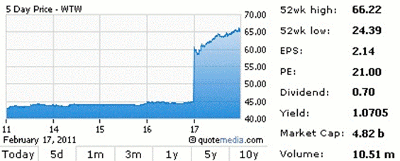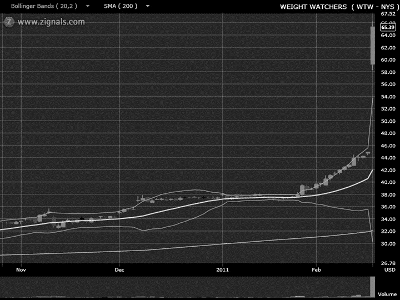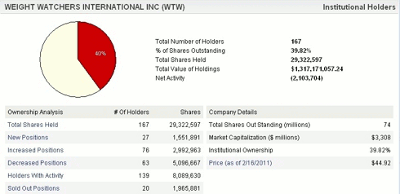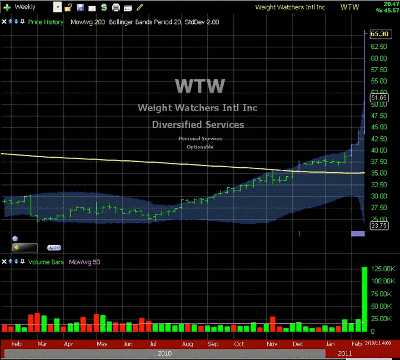Share price and volume exploded last week, but poor fundamentals and mounting risk factors could be a recipe for losses.
Weight Watchers International, Inc. (WTW), a $4.82 billion New York-based weight management services company, had a feeding frenzy on Wall Street on Friday (Feb. 18).
It is not often that one watches a stock with negative equity rip up 45% in one day to close out above $65. It was quite a show put on by investors that decided it was a good time to buy WTW. It was easy for buyers to find other buyers today that would pay more, but the real question is who is going to pay more this week?
Last Thursday, though, WTW experienced about a tenfold increase in volume, which topped out over ten million shares.
Daily Chart: Bollinger Bands and 200-Day Moving Average
Earnings results came out on Thursday, Feb. 17 and surprised many. Excluding items, Q4 2010 bottom line was $47.6 million, resulting in earnings per share of $.64, according to the press release and EDGAR Online. With a closing price of $65.39, this results in an annualized P/E of 25.54. WTW provided forward guidance of between $3.50 and $3.85 per fully diluted share. If we use a bottom line number of $3.75 per fully diluted share, it results in a forward P/E of about 17.43.
This doesn’t sound all that bad. Maybe the price is a little rich on the face of it, but not too bad for a growing company if everything else looks good. It is the “everything else” part that makes it appear that perhaps WTW’s price has become overweight. Total assets grew from $1.087 billion in January 2010 to $1.092 billion in January 2011, or about half of one percent. I doubt that played a part in the rise of the stock price.
Of the total assets, $847.3 million is in “Goodwill and other intangible assets” and is an increase of about $5.5 million over the previous year. Stripping out the increase the company places on the increase in goodwill, the other assets actually fell year over year. Current assets fell by over $9 million and property and equipment fell by over $5 million. Total liabilities went from $1.82 billion in January 2010 to $1.78 billion in January 2011, leaving a book value for WTW of a negative $690 million. That’s right, investors who bought WTW paid up and higher for a company that owes more than it is worth. Take out the “goodwill,” which in a trouble situation would fall in value very quickly, and this company could reasonably be valued at less than negative one billion dollars. Talk about a heavy debt load to carry!
NEXT: Key Risk Factors Could Threaten the Stock
|pagebreak|One misstep and the price of the stock could come down quickly. With a negative equity from the very beginning of its IPO a few years ago, this seems to be a ticking time bomb. WTW appears to be a heart attack waiting to happen and is caused by a massive appetite for debt. While the cost of the debt load appears to be kept artificially low due to quantitative easing 2.0, what will happen if interest rates rise and refinancing is needed?
One answer could be in the number of shares outstanding. In 2008, WTW repurchased shares. With a price about $45 per share, the shares could now be put back on the market and make management look good for buying when they did. Revenue could be used to pay down debt.
There are many missteps that could happen, and here is a selection of what the company finds to be risk factors going forward, as reported in the last annual statement:
“Competition from other weight management industry participants or the development of more effective or more favorably perceived weight management methods could result in decreased demand for our services and products.”
“If we do not continue to develop innovative new services and products or if our services and products do not continue to appeal to the market, our business may suffer.”
“Our business depends on the effectiveness of our marketing and advertising programs to attract and retain members and subscribers.”
“The seasonal nature of our business could cause our operating results to fluctuate.”
“Our businesses are subject to legislative and regulatory restrictions.”
“Artal controls us and may have conflicts of interest with other shareholders in the future.“
“Our articles of incorporation and bylaws and Virginia corporate law contain provisions that may discourage a takeover attempt.”
I suggest reading the entire annual statement. It is a great deal of reading, for sure, but it is only some of the risk factors listed in the last annual statement. One risk factor that is not listed but that I think should be is the climbing cost of food products. Core inflation may not include fuel or food, but most of the people I know spend a lot of their money on both. If food prices continue higher, this may impact the ability of WTW to sell its products.
Those are the fundamental reasons why I believe WTW has gone too far too fast like stocks so often do. From a technical point of view, when a stock has a run up prior to earnings or some other major news event and then blasts off as if going straight up, it tends to retrace much of the move higher. Some stocks that I have recently wrote about that have done this exact thing include JDS Uniphase Corp. (JDSU), which ran up in price after moving in a straight line (up from the 200-day moving average), and NPS Pharmaceuticals (NPSP), which I think captures the chart very well compared to WTW.
Typically, what I find happens is that after stretching so far, much like a rubber band, stocks tend to pull back a little the day after a run up. The second day, when investor attitudes start to change and they realize the music may be stopping without enough chairs, the stock really pulls back. I would suspect that this week will not be as kind to investors of WTW as last week was.
Weekly Chart: Bollinger Bands and 200-Day Moving Average
I use a proprietary mix of technical analysis, financial crowd behavior, and fundamentals in my short-term trades. While not exactly the same in longer swing trades to investments, the concepts used are similar. I believe the company and the company stock correlation have separated, thus leaving the stock to be overpriced relative to the performance of the company. I also believe that WTW will see some profit early this week.
By Robert Weinstein of Paid2Trade.com.

























